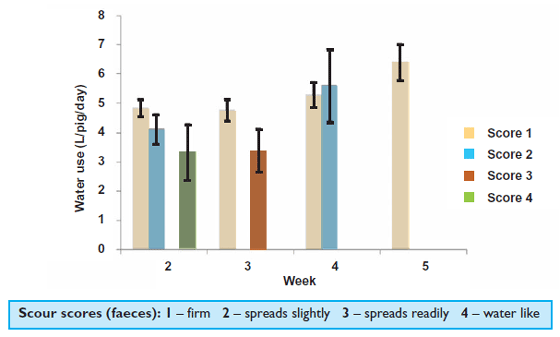



Monitoring Water Consumption to Assist Health Management
Automated monitoring of water consumption could provide a sensitive tool for real-time, continuous, monitoring for the presence of sub-clinical disease in growing herds, according to No. 14 in the 'Research into Action' series from BPEX.The drinking behaviour of diseased pigs has been found to deviate from the consistent patterns seen in healthy pigs; the behavioural changes appear in the sub-clinical stage of infection, before disease symptoms become visually apparent. Therefore, the automated monitoring of water consumption could provide a sensitive tool for real-time, continuous, monitoring for the presence of sub-clinical disease in growing herds.
Previous work has examined changes within daily water consumption and found whole building and room consumption patterns to be sensitive indicators for all-in, all-out systems. Research at Newcastle University investigated the sensitivity of monitoring water on a more detailed level, using total daily water consumption at pen level, for deviations in daily water intake patterns that could indicate changes in health and performance.
Trial Details
Over two replicates, the daily water consumption of 24 pens of finishing pigs was monitored from entry to the finishing building (52.6kg) until exit for slaughter (85.3kg).
Water was available ad libitum via two nipple drinkers per pen.
To determine influence of drinker type, two types of commercial drinker were fitted equally across pens.
Water meters fitted to the downpipe supplying each pen logged water use at five-minute intervals. Sensors logged internal and external barn temperature.
Meters and sensors were linked to a computer modem (Barn Report, Farmex Ltd.), from where data could be accessed via an internet connection.
Clinical disease symptoms and veterinary treatments were recorded for each pen daily; cough, diarrhoea and sneeze scores were recorded for each pen weekly.
Pig weights were recorded every two weeks. Pen feed consumption was recorded in the second replicate.

Trial Results
Pigs took on average 6.6 weeks to reach slaughter weight. The average daily gain of all pigs was 0.70kg per day. Water consumption increased linearly, with a lower rate of increase as pigs neared slaughter weight. On average, pigs consumed (use plus wastage) 7.07 litres of water per kg of gain.
Daily variation in water use per pen was influenced by the weight of the pigs, the number of pigs within the pen, daily live weight gain, drinker type and the external minimum and external maximum building temperatures, accounting for 53 per cent of the total variation in daily water consumption.
Relationships were found between water use and pig body weight, average daily gain, FCR, building temperature and group size.
The average pen water consumption per pig in relation to observed symptoms of disease (as recorded by the health scores), showed a reduction in water consumption in pens in suffering from scour at a clinical score of four in week two of the trial (Figure 1). However, this reduction was not statistically significant (P=0.124). Of relevance to sub-clinical disease detection, pens scored for occurrence of scour in the following week (one week later), had a strong tendency (P=0.067) towards reduced water consumption in the current week (Figure 2).


(T=P=0.067)
Conclusions
Even when recorded at a more detailed pen level, this study demonstrates the potential of water consumption patterns as a powerful tool to monitor pig health.
Although at the level of a tendency, the reduction in water consumption in relation to the severity of scour is an encouraging finding for water consumption recorded at the pen level. A larger sample is needed to see if this would become statistically significant.
The relationships between body weight, live weight gain, feed intake, temperature and group size suggest the potential for modelling of water consumption to a level that delivers information not only on current and predictive information on pig health, but also of the rate of feed intake and growth performance.
Research is on-going in this area and in the long run could develop a sophisticated, fully automated monitoring package for producers to simultaneously monitor environmental performance and health.
References
Crabtree, H.G., Bird, N., Ravn, L. and Edwards, S.A. 2008. Changes in water intake patterns as an automated early indicator of pig welfare problems. Proceedings of the 4th International Workshop on the Assessment of Animal Welfare at Farm and Group Level. 82.
February 2013








